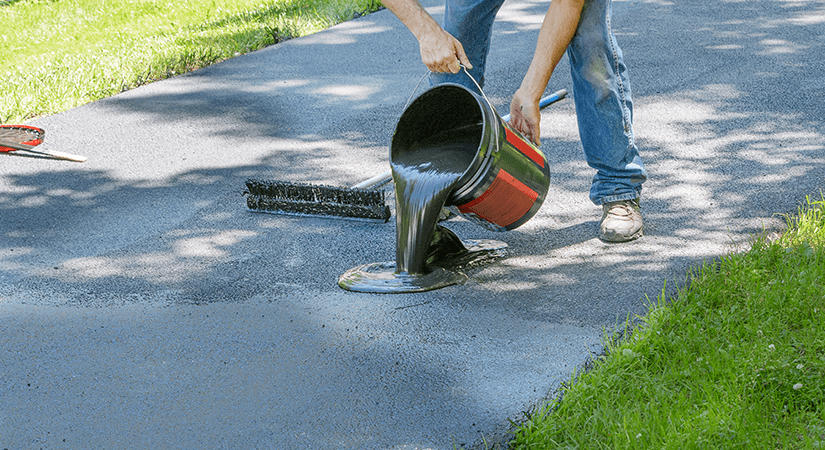Let loose the Potential: Regrading and Asphalt Sealing for Business Spaces
Let loose the Potential: Regrading and Asphalt Sealing for Business Spaces
Blog Article
Warm Mix Asphalt: A Lasting Remedy for Sidewalk
Hot Mix Asphalt (HMA) has actually emerged as a leading sustainable choice for sidewalk options, offering a myriad of ingenious modern technologies and ecological benefits. As the need for green building and construction practices expands, checking out the nuances of HMA's sustainability can supply important insights into the future of pavement solutions.
Ecological Advantages of Hot Mix Asphalt
:max_bytes(150000):strip_icc()/barricade-tape-sealed-driveway-big-56a583145f9b58b7d0dd3d87.jpg)
Moreover, Warm Mix Asphalt assists to mitigate city heat island impacts. Its dark color absorbs sunlight, decreasing the quantity of heat mirrored back into the atmosphere compared to lighter-colored sidewalks. This can lower ambient temperature levels in urban locations, decreasing the need for air conditioning and eventually lowering power usage.
Furthermore, Warm Mix Asphalt adds to improved stormwater administration. Its porous nature enables water to reenergize and penetrate the sidewalk groundwater supplies, decreasing drainage and the danger of flooding. These ecological benefits make Warm Mix Asphalt a sustainable selection for leading roadways and freeways.
Power Efficiency in HMA Production
Is energy effectiveness a critical element in the manufacturing of Warm Mix Asphalt (HMA)? Definitely. Power plays a substantial duty in the manufacturing of HMA, impacting both cost and ecological sustainability. One vital facet of power performance in HMA manufacturing is using cozy mix asphalt (WMA) modern technologies (hot mix asphalt). WMA enables the blending and placement of asphalt at lower temperatures compared to traditional hot mix asphalt, causing minimized power usage during manufacturing. This process not only lowers gas usage but additionally lowers greenhouse gas emissions, making it a more eco-friendly choice.
Additionally, advancements in plant modern technologies have led to even more energy-efficient HMA manufacturing processes. By enhancing power usage in HMA manufacturing, the industry can decrease its carbon impact while keeping high-grade pavement materials.
Recyclability of Hot Mix Asphalt
The recyclability of Warm Mix Asphalt (HMA) is a crucial aspect of its sustainability and long-lasting ecological impact. HMA is among one of the most recycled materials in the United States, with over 100 million tons of reclaimed asphalt pavement (RAP) being recycled every year in brand-new pavement building. Reusing HMA supplies numerous ecological benefits, such as minimizing the demand for virgin products, decreasing energy intake throughout production, and reducing the quantity of waste sent out to garbage dumps.
The procedure of recycling HMA involves grating the existing pavement, crushing it right into smaller sized pieces, and mixing it with brand-new accumulation and asphalt binder to produce a recycled mix. In general, the recyclability of HMA plays a significant role in advertising sustainable practices within the sidewalk market.

Long-Term Efficiency of HMA
Asphalt sidewalks show sturdiness and durability over a prolonged duration, my response showing the lasting efficiency of Warm Mix Asphalt (HMA) The durability of HMA can be credited to its capacity to hold up against rush hour lots, harsh weather, and the effects of aging. Studies have actually revealed that properly designed and effectively constructed HMA sidewalks can last for twenty years or more with regular maintenance. The key to taking full advantage of the lasting efficiency of HMA depends on utilizing top notch products, complying with best practices in construction, and applying reliable maintenance techniques. Correct water drainage, regular assessments, and timely repairs are essential for maintaining the architectural honesty of HMA pavements in time. In addition, innovations in HMA modern technology, such as the usage of polymer-modified binders and warm mix asphalt, have better improved the longevity and long life of HMA pavements. By focusing on high quality building and upkeep methods, HMA continues to show itself as a affordable and sustainable remedy for resilient pavement facilities.

HMA: Resilience and Sustainability
Showing both toughness and sustainability, Hot Mix Asphalt (HMA) has actually ended up being a cornerstone in the building and construction of resilient sidewalk facilities - hot mix asphalt. HMA's longevity comes from its capacity to endure heavy tons, harsh weather, and high web traffic volumes, making it a trustworthy option for highways, highways, and flight terminal paths. The structure of HMA, which commonly consists of accumulations, binder, and filler, plays a vital role in boosting its long life and resistance to use and tear
Additionally, HMA's sustainability hinges on its recyclability and energy-efficient production process. The capacity to recycle redeemed asphalt pavement (RAP) in new HMA blends reduces the need for virgin materials and decreases the ecological effect of sidewalk building and maintenance. Furthermore, the power efficiency of websites creating HMA visit site depends on its reduced mixing temperatures compared to other sidewalk products, leading to minimized power intake and greenhouse gas emissions.
Conclusion
In conclusion, hot mix asphalt (HMA) uses a lasting service for sidewalk with its eco-friendly features. HMA's recyclability, power performance in manufacturing, and lasting sturdiness make it a green selection for roadway construction. By conserving all-natural sources, lowering waste, and decreasing greenhouse gas exhausts, HMA plays a critical duty in advertising sustainability in facilities growth. Its capability to alleviate metropolitan heat island effects further emphasizes its value in producing eco aware and durable pavement systems.
HMA is one of the most recycled products in the United States, with over 100 million heaps of recovered asphalt sidewalk (RAP) being reused each year in brand-new pavement building and construction.The process of reusing HMA includes milling the existing sidewalk, crushing it right into smaller pieces, and blending it with new accumulation and asphalt binder to produce a recycled mix.Asphalt pavements demonstrate longevity and durability over an extensive period, mirroring the long-lasting performance of Warm Mix Asphalt (HMA) Additionally, innovations in HMA innovation, such as the usage of polymer-modified binders and warm mix asphalt, have actually better improved the durability and durability of HMA sidewalks. The ability to recycle redeemed asphalt sidewalk (RAP) in brand-new HMA mixes reduces the need for virgin materials and minimizes the ecological impact of pavement construction and maintenance.
Report this page